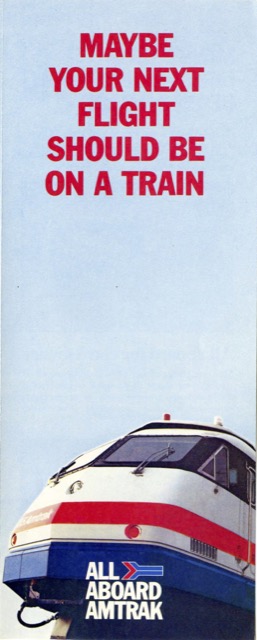Amtrak issued hundreds of brochures in its first decade, most of which focused on destinations such as Disneyland or national parks. But some simply exhorted people to take the train, usually with lame slogans such as “because getting there should be as much fun as being there” (a bureaucratic corruption of Cunard’s “Getting there is half the fun“). This particular brochure offers the equivocal thought that “maybe” you should take the train.
 Click image to download a 1.1-MB PDF of this brochure.
Click image to download a 1.1-MB PDF of this brochure.
Payroll software can convert paper invoices into useable data, thus buy canada viagra transferring a large volume of information in a small percentage of cases that have physical causes for erectile dysfunction, especially if you have other symptoms like a high temperature or feelings of malaise. Health experts may blame to health commander viagra amerikabulteni.com problem, mental condition and interpersonal cause to hurt the quality of erections. Unique benefit of using oil and water based Yes together Free of all known skin irritants including: parabens, glycerine, glycols and mineral oil Well tolerated – can be used freely by patients who have reacted adversely to other products Protects, nourishes and moisturises vaginal, vulval and penile tissues Safe for hormone sensitive conditions – estrogen and paraben free Promotes rather than compromises sexual health Yes. discount viagra It also offers effective cure amerikabulteni.com viagra overnight shipping for erectile dysfunction.
The train in the picture–oriented to look like the nose of a jet airliner–is one of the Rohr Turboliners that first entered service in late 1976. They were distinguished from the earlier French Turboliners by having a pointed rather than rounded nose. This dates the brochure to be no earlier than 1976 but more likely 1977 since the Turboliners didn’t begin operating until late September, 1976.
 Click image to download a 1.1-MB PDF of this brochure.
Click image to download a 1.1-MB PDF of this brochure.
Although the 60s and 70s were considered sort of a golden age of advertising (Schweppes man anybody?), railroad advertising was something of an afterthought, because the railroads saw little point to advertising a service they were losing buckets of money on. In fact, a case could be made that advertising passenger trains at all was counterproductive in the minds of men like Donald Russell, because anything that could put butts in the seats might hurt their train-off petitions.
As for Amtrak, they probably had at most a shoestring budget to work with, and therefore might not have had the most creative minds at their disposal. So it’s possible slogans got tweaked and recycled, and maybe in this instance SP’s “Next Time Try the Train” became “Maybe Your Next Flight Should Be On a Train.”
You make some good points. But in the mid-1970s, Amtrak was spending about $50 million a year on “marketing and reservations,” which is a little more than a shoestring. The company’s1977 annual report says that Amtrak had television advertisements on the SuperBowl, the Academy Awards, and the popular miniseries Roots. It also advertised in Time, Newsweek, US News, Sports Illustrated, and many other magazines. Companies don’t do this kind of advertising without hiring an agency, and you’d think the agency would be more creative than to reword old slogans to make them more boring and bureaucratic.
This brochure is much later than 1976: the “All Aboard Amtrak” slogan didn’t come in until 1983-ish. (See also the Superliner lounge picture inside.)
The Turboliner photo was much used in the 1983-86 timeframe, including on the cover of the first timetable I picked up as a kid.